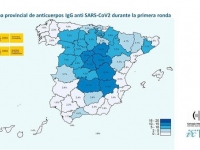Health
5% of Spanish population developed antibodies against COVID-19
According to an study
USPA NEWS -
The Spanish Minister for Health, Salvador Illa, presented, together with the Minister for Science and Innovation, Pedro Duque, the main provisional results from the national epidemiology study ENECovid19, corresponding to the first of three waves that make up the study.
Due to the size of the sample, this is one of the most ambitious studies with these characteristics in the world, which both Ministers Illa and Duque underlined in their speeches. Designed by the Ministry of Health and the Carlos III Health Institute (Spanish acronym: ISCIII) with the collaboration of the National Statistics Institute (Spanish acronym: INE) and the regional governments, this will help to see how many people are or have been in contact with the virus and see whether they remain immune over time.
Minister Illa stressed that it was necessary to have this preliminary result to assess the decisions taken. In this regard, he underlined that the government's actions head in the right direction and that the lockdown has been a success. For his part, Minister Duque highlighted that "science is fuelled by data and these will be very important." That is why he expressed his conviction that the study will mark "a before and after in Spanish science in the fight against the pandemic."
Initial conclusions
According to the initial conclusions, the prevalence of IgG antibodies against SARS-Cov-2 in the Spanish population stands at 5%, at a very similar level between men and women. It is lower among babies, children and young people, and is quite stable in older age groups. Furthermore, 87% of the referred participants that had tested positive in the PCR test presented IgG antibodies. In the potentially suspicious cases, the prevalence increases with the number of symptoms. It was particularly high - at 43% - in people with anosmia (total loss of smell). Finally, 2.5% of participants who showed no symptoms had developed IgG antibodies.
By regions, there is a marked geographic variability. Accordingly, Ceuta, Murcia, Melilla, Asturias and the Canary Islands showed a prevalence of less than 2%, while the Region of Madrid and Castile-La Mancha, exceeded 10%. On the map of provinces, the central group of provinces stood out with a prevalence equal to or close to 10% in the area around Madrid. Furthermore, the map of potentially suspicious COVID-19 cases (people with three of more symptoms or a total loss of smell) also stood out in this central area of Spain, with a prevalence of close to 20%, although equally high values were also recorded in some other provinces.
These results are provisional and correspond to the rapid tests carried out since 27 April on 60,983 people in the national sample. They do not include the other 3,234 samples taken in the specific island study, carried out in Fuerteventura, Lanzarote, La Gomera, El Hierro, La Palma, Formentera, Minorca, and an additional sampling in Ibiza.
Three phases
In this first phase, 35,000 households were called at random around Spain. In parallel, samples were taken from participants at health centres and at home. On the one hand, a rapid test was performed to determine the antibodies in the blood, by pricking the finger. To ensure the reliability of the results and to apply the utmost methodological rigour, additional blood samples by venepuncture (prick in the arm) were obtained from those participants that gave their consent.
The results presented on Wednesday afternoon do not include information from this second type of test, which measures antibodies by immunoassay, since not all the results have been gathered from the different regions. In the next waves, considers Spanish Government, it will be possible to see the evolution of the prevalence and the changes observed in participants over time.
Liability for this article lies with the author, who also holds the copyright. Editorial content from USPA may be quoted on other websites as long as the quote comprises no more than 5% of the entire text, is marked as such and the source is named (via hyperlink).






